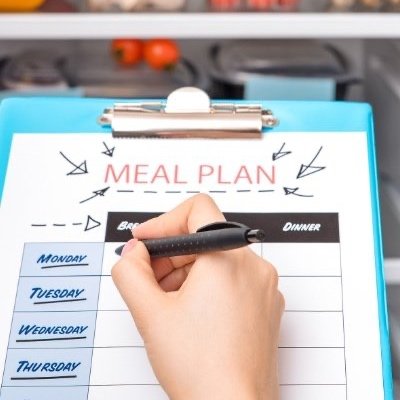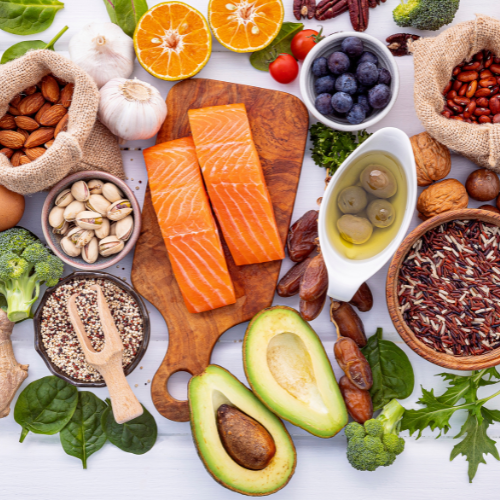10 Ways to Reduce Calories
When it comes to fat loss, it’s all about energy balance.
While many people mistakenly believe they can just burn off their fat through exercise alone, the most effective way to achieve fat loss is by managing what you eat.
Body fat is the primary way our bodies store energy from our food. When the food we eat has more energy than what our bodies spend, the excess energy often gets stored as fat.
We measure the energy from our food in calories. You can tell exactly how much energy a food has by looking at the number of calories per serving on the food label or by looking it up in a calorie tracking app like MyFitnessPal.
If you want your body to burn fat, you need to make sure that your body is in a calorie deficit—meaning you eat fewer calories than what your body spends on most days.
Reducing your caloric intake in addition to a well-rounded exercise routine (one that includes resistance training and activity on most days) is the best approach for achieving long-term and sustainable fat loss.
Let’s take a look at some ways you can reduce your calorie intake and encourage your body to tap into its fat stores.
1 Track What You Eat
The number one way to reduce your caloric intake is to use a food journal or tracking app like MyFitnessPal to log what you eat. This allows you to keep a close eye on your calories and adjust what you eat to stay within your daily goal.
Tracking also helps you become more familiar with the calorie content of the foods you eat frequently. As you learn how many calories are in your favorite foods, you’ll be able to eat more intuitively in the future without having to track as much.
Keeping a food log also can help you develop self-awareness around your eating habits. You may not realize how much soda or coffee you drink every day until you begin to keep a diary. As you identify your patterns, you’ll be able to build better habits to keep your daily calorie intake where it needs to be.
Download my free printable Nutrition Tracking sheets if you prefer pen-and-paper by clicking below:
2 Pay Attention to Portions
It’s easy to overshoot your calories if you aren’t paying attention to how much food you put on your plate. Measuring your food will allow you to more accurately keep an eye on your calorie intake.
Whenever you go to eat something, check out the recommended serving size on the nutrition label or look the food up on MyFitnessPal. Then measure the amount of food you put on your plate by weighing it or by using measuring spoons or cups. Enter the amount of the food that you eat in your food journal or MyFitnessPal.
3 Plan and Prepare Meals
If you struggle to make healthy choices at meal times, consider planning your meals in advance.
MyFitnessPal allows you to plan meals for the future and enter them into your food log ahead of time. Search for and select foods to fill out a day, a few days, or even a week ahead—keeping your daily calorie intake within your limit. At meal times, just check your food log for what you have planned and follow the plan. Easy peasy!
If you plan to cook at home, you can enter recipes into MyFitnessPal to determine the calorie content of each serving so you know how much to put on your plate at meal times.
You’ll have even more success if you also prepare your meals ahead of when you eat them (this practice is called ‘meal prep’). This allows you to make healthier choices and avoid impulsive, calorie-laden snacks or fast food options.
4 Eat More Fiber-Rich Foods
If you’re following the Healthy Plate model, you know that half of your plate at every meal should come from vegetables (or fruits and vegetables).
Vegetables, whole grains, legumes, and fruits are high in dietary fiber, which aids in digestion and helps you feel full on relatively few calories. You can eat a lot of vegetables without moving the needle much on your daily calorie intake. For this reason, the popular fat loss program Weight Watchers calls vegetables ZeroPoint foods.
Foods high in soluble fiber like oats, beans, legumes, vegetables, fruits, nuts, and seeds also help to combat belly fat.
5 Eat More Lean Protein Foods
Eating plenty of lean sources of protein is another great way to reduce your calorie intake.
Protein-rich foods help you feel fuller for longer periods, which can help you avoid over-eating or mindlessly snacking.
The Recommended Dietary Allowance (RDA) for protein is 0.8 grams of protein per kilogram of body weight (0.36 grams per pound). If you are active or exercise, your body needs even more protein (between 1.5 and 2.2 grams per kilogram of body weight or 0.7 and 1 gram per pound).
It’s important to choose sources of protein that are low in saturated fat. Saturated fat comes mainly from animal fats (fatty cuts of meat, skin, yolk, and cream). You can get plenty of lean protein by choosing lean cuts of meat, white meat (like chicken breast and turkey breast), fish, egg whites, and low-fat or no-fat varieties of milk, yogurt, and cheese. Vegetable sources of protein like beans and legumes are also free from saturated fat.
6 Limit Liquid Calories
Many people don’t realize how many extra calories they consume through the beverages they drink. Some of my clients drink as many as 5 sodas a day, which can easily rack up as many as 900 extra calories per day! Sugary or flavored coffees can also add hidden calories to your daily intake (a tall Starbucks Caramel Macchiato has about 190 calories per serving—about the same as a can of soda).
To avoid liquid calories sneaking up on you, make sure to check the nutrition label and track what you eat and drink in your food log or MyFitnessPal. Either budget for however many calories you plan on having from sodas or restrict your intake to just 1 or 2 sodas per day.
You can get away with drinking more soda by switching to a zero-calorie or low-calorie alternative like Olipop.
7 Limit Highly Processed Foods
Highly processed foods like breakfast cereals, chips, crackers, and other snack foods often contain hidden calories from added sugars, unhealthy fats, and refined carbohydrates. These foods also tend to be highly addictive and not very filling—so it’s easy to overeat and overshoot your calories by a long shot.
As much as possible, opt for whole, unprocessed foods like fresh vegetables, fruits, nuts, seeds, and meat. Minimally processed foods like dairy products (e.g., low-fat milk, Greek yogurt, cottage cheese) are also okay.
8 Choose Low-Calorie Options
If you enjoy sweet or salty snacks and desserts, opt for low-calorie versions whenever possible.
Anyone who follows my live streams on Twitch knows that I go absolutely feral for cheesy, salty chips like Cheetos. I go through periods where I crave Cheetos every day! To avoid overdoing it on my calories, I often get the lower-calorie puffed Cheddar rice crisps.
Keep in mind that artificial sweeteners are a safe low-calorie alternative to sugary foods when you follow the daily recommended amounts. Some people have claimed a link between certain artificial sweeteners to cancer (most notably, a 1978 study demonstrated the carcinogenic effects of saccharin in rats). However, the vast majority of studies on humans have yet to demonstrate any negative health effects from consuming artificial sweeteners.
9 Drink Plenty of Water
There’s a reason why I carry around a giant 2-liter water bottle with me everywhere—drinking plenty of water is so important for staying healthy and avoiding mindless snacking.
People often mistake their body’s thirst signals for appetite or hunger. So next time you’re feeling snackish, drink a glass of water and wait 30 minutes. You might just find that you weren’t actually hungry—you were dehydrated!
Drinking a glass of water before meals can also help curb your appetite and make you feel fuller sooner. This can help you to avoid overeating and overshooting your calorie goal during the meal.
10 Mindful Eating
You can easily eat too much when you don’t pay attention to your body’s signals for hunger and fullness. You may find it hard to eat the right amount consistently if you’re constantly distracted by working, watching tv, or scrolling social media.
So instead, cultivate a mindful approach to eating by getting familiar with your body’s cues for hunger and fullness.
Hunger might express itself as:
thinking about food
stomach grumbling, feeling empty, or gnawing
irritability or “hanger”
low energy or fatigue
difficulty concentrating
lightheadedness
feeling nauseous, shaky, or faint
acid reflex
headache
If you notice any of the above signs, honor your body’s signals and get something to eat!
Whenever you eat, practice eating slowly and savor each bite. Check in with how you feel as you eat and stop when you feel physically full or when you notice that the food doesn’t taste as good as it did at the beginning of the meal.
If you struggle in reading your body’s cues, consider meal planning and portioning your meals and snacks ahead of time to ensure you eat the right amount.
More Guidance
If you need more support with your fat loss journey, I have a bunch of options:
Make sure to join the email list using the form below and under “I’m interested in emails about,” select “Fat Loss Tips.”
For more guidance on how to eat for fat loss, check out my Healthy Diet Makeover program, where you’ll learn how to clean up your diet and eat for fat loss.
If you’d like to work with me directly, you can apply for 1-on-1 coaching.
Remember that you can always ask questions when I’m live on my Twitch channel throughout the week. Follow me on Twitch and join the Coaching Corner Discord to get notified whenever I go live.
About Jayd
Hey there! 👋 I’m Jayd Harrison (aka Jaydigains), a health coach, personal trainer, and host of the Coaching Corner Podcast. I help people build muscle, burn fat, and clean up their diets with my online coaching programs and fitness content. Check out some of my coaching videos on Youtube, join me live on Twitch, and follow on social media.
Sign up for updates ✉️
Sign up for more exercise tips and get notified whenever I post to the Fat Loss Blog. Fill out the form below:
Your privacy is important to me! I will never share your information with any third party. Update your preferences or unsubscribe from the email list at any time.




